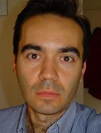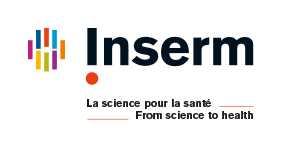 |
Thierry Galli, directeur (DU) |
 |
Elisabeth Davenas, Secrétaire Générale (SG) |
 |
 |
Diana Zala et Nicolas Ramoz, Coordinateurs responsables de la Formation et Communication (Training and Communication, TCC) |
|
|
 |
Pierre Billuart et Pascale Varlet Coordinateurs responsables de la Recherche Translationnelle (Translational Research Coordinator, TRC) |
 |
|
Gwenaëlle Le Pen et David Tareste, Coordinateurs responsables des Plateformes Technologiques (Technological Platforms Coordinator, TPC) |
Coordinatrice scientifique, Clara Martinez Rico
Responsables d’équipes:
Alessandra Pierani, Anne Joutel, Belen Pardi, Catherine Oppenheim, Fani Koukouli, Gilles Huberfeld, Guillaume Van Niel, Guillaume Turc, María Cecilia Angulo, Marie-Odile Krebs, Philip Gorwood, Rebecca Piskorowski, Thierry Galli, Urs Böhm, et Zsolt Lenkei
Responsables de plateformes:
Chercheurs permanents : Pierre Billuart, Diana Zala, Pascale Varlet, Nicolas Ramoz, Gwenaëlle Le Pen, David Tareste, Boris Chaumette, Aude Marzo, Lydia Danglot
Chercheurs non permanents (post-doc et étudiants) : Elisa Dziezuk, Baptiste Allain, Louis Barthe, Ivan Kortza
Techniciens et ingénieurs : Celia Espinoza, Ludivine Therreau, Nadège D'Araujo, Nicolas Lebrun, Sylvain Charron
La Direction : Thierry Galli et Elisabeth Davenas
Le conseil consultatif scientifique international ou international Scientific Advisory Board (iSAB) conseille le Directeur et les tutelles de l'Unité sur sa stratégie scientifique et la sélection des chefs d'équipe. Il évalue la qualité de la recherche, l'organisation et la gestion de l'IPNP.
L'iSAB est composé de 6 scientifiques renommés dans le domaine de la psychiatrie et des neurosciences et travaillant hors de France. Trois des 6 membres de l'iSAB sont impliqués dans la recherche clinique et les trois autres membres le sont dans la recherche fondamentale.
 |
Prof. Volker Haucke, iSAB President, Full Professor of Molecular Pharmacology, Freie Universität Berlin & Director at the Leibniz Forschungsinstitut für Molekulare Pharmakologie (FMP), Berlin, Germany. X (@VolkerHaucke) Key words: Neurotransmission, Cell signaling, Exo-endocytic Membrane Dynamics, Optical imaging, Neurodegeneration, Epilepsy |
Volker Haucke received his PhD summa cum laude in 1997 from the Biozententrum of the University of Basel, Switzerland, for his work on mitochondrial biogenesis in the group of Gottfried (Jeff) Schatz. Following postdoctoral work as a fellow of EMBO and the Human Frontier Science Program in the group of Pietro De Camilli at Yale University School of Medicine he started his own laboratory at the University of Göttingen. He was appointed as a full professor of biochemistry at the Freie Universiät Berlin in 2003. Since 2012 Volker Haucke is director at the Leibniz Forschungsinstitut für Molekulare Pharmacologie (FMP) and professor of molecular pharmacology at the Freie Universität Berlin and a member of the NeuroCure Cluster of Excellence.
The focus of research in his laboratory is the dissection of the molecular mechanisms of endocytosis and endolysosomal membrane dynamics and its role in the nervous system with a focus on neurotransmission. The laboratory uses a wide range of technologies that include biochemical and cell biological approaches, electrophysiology, chemical biology, super-resolution and electron microscopy as well as genetic manipulations at the organismic level in vivo. The overarching goal of these studies is to mechanistically understand how exo-endocytosis and the endolysosomal system contribute to the development and maintenance of the nervous system function and how dysfunction may lead to neurological diseases. Among his major discoveries are the identification of novel lipid conversion mechanisms that control exo-endocytosis (1,2), nutrient signaling (3,4), lysosome function (5), and presynapse formation via axonal transport of a lysosome-related precursor organelle (6). His lab has identified important pathways for the control of neurotransmission by endocytic proteins (7-9) and by neuronal autophagy (10).
Prof. Haucke is a distinguished scientist whose contributions have been recognized by his election as a Member of the Academy of Europe (AE), German National Academy of Science Leopoldina, and the Berlin-Brandenburg Academy of Science (BBAW), by the Avanti Award of the American Society for Biochemistry and Molecular Biology (ASBMB) 2017, and the Feldberg Prize for Research in Physiology and Pharmacology 2020. Since 2014 he is also an elected member of the European Molecular Biology Organisation (EMBO).
Selected publications:
 |
Prof. Claudia Bagni, Full professor, Faculty of Biology and Medicine of the University of Lausanne, Switzerland & Faculty of Medicine of the University of Rome Tor Vergata, Italy. X (@BagniLab) Key words: Neurodevelopment, Synaptic Plasticity, mRNA Metabolism, Protein Homeostasis, Cytoskeleton Remodeling, Synaptopathies, Autism, Fragile X Syndrome, ASD-Like Behaviours |
Prof. Claudia Bagni completed her undergraduate studies in Biology and her Ph.D. in Cellular and Molecular Biology at the University of Rome Tor Vergata, Italy. She carried out postdoctoral research at the CNRS in Toulouse, France, Harvard University, USA and EMBL, Germany. In 1998 she established her group as assistant professor at the University of Rome Tor Vergata, to continue from 2008 to 2016 as full professor and group leader at the K University of Leuven - VIB, Belgium. From 2016 to 2021 she has been the Director of the Department of Fundamental Neurosciences at the University of Lausanne, Switzerland and became Vice-Dean research and innovation in 2021.
Her ultimate goal is to understand how the interplay between RNA metabolism and actin remodeling regulates synapse physiology, pathology and ultimately brain activity and behavior. She has a profound interest for certain synaptopathies such as fragile X syndrome and autism in which the recurring aspect is the dysregulation of the synaptic proteome. Her research group uses Drosophila melanogaster and mouse models to understand how deficits in synaptic molecular mechanisms ultimately affect different types of behaviors such as cognitive flexibility and social behavior. For a complete understanding of these complex pathologies she has long lasting collaborations with clinicians.
She is a member of the European Molecular Biology Organisation (EMBO), and has received several national and international awards, including the UCB Award in 2014, the Solvay Price in 2016 by the Queen Elisabeth Medical Foundation (Belgium), in 2018 the Nestlé Research & Development Women in Science Award (Switzerland) and in 2023 she was nominated by the Italian President of the Italian Republic Knight of the Order of Merit of the Italian Republic (Cavaliere O.M.R.I).
 |
Prof. Gaia Novarino, Professor at Institute of Science and Technology Austria (ISTA), Klosterneuburg, Austria. X (@gaianovarino) Key words: Genetics, Next Generation Sequencing, Genomics, Dna Sequencing, Genetic Analysis, Sequencing, Gene Expression, Transcriptomics, Molecular Biology, Neuroscience, Neurodevelopmental disorders, Autism, Epilepsy |
Gaia Novarino, an Italian native, obtained the Ph.D. in developmental biology from the University “La Sapienza” (Rome, Italy) in 2006. As a graduate student in Rome, she employed electrophysiology and cell biology techniques to study the role a putative chloride channel in microglia activation. In 2004 she moved to Germany where she joined the laboratory of Thomas Jentsch at the Max Delbruck Center for Molecular Medicine (Berlin, Germany). In the Jentsch’s lab she developed a project that contributed significantly to the understanding of the basic mechanism underlying Dent’s disease, an X-linked disorder caused by mutations in CLCN5. While in Thomas Jentsch’s lab, she also studied CLCN4, a chloride transporter associated with intellectual disability. Ever since she has developed a strong interest in studying neurological disorders.
In 2010 Gaia moved to San Diego (California, USA) where she joined the laboratory of Joseph J. Gleeson at UCSD. In the Gleeson’s lab she employed human genetics, functional and network analysis to identify and study novel genetic causes of epilepsy, autism and intellectual disability.
RESEARCH INTERESTS
My main research interest is to identify and study genes underlying inherited forms of neurodevelopmental disorders such as autism, intellectual disability and epilepsy. Neurodevelopmental disorders affect millions of people, and are often refractory to treatments. The causes of these disorders remain unknown for the majority of cases. Of these, a significant number have a genetic basis and many causative genes remain to be identified. With DNA sequencing being more accessible, the genomes of many patients can be analyzed and more disease-causing genes will be recognized. Even though we predict that each identified gene may represent only a tiny fraction of the total genes involved in these disorders, studying the mechanisms underlying rare inherited forms of neurodevelopmental disorders can be extremely helpful. For instance, similarities among the function of genes implicated in autism, intellectual disability and epilepsy may point to a smaller number of pathways that are generally affected in neurodevelopmental disorders. Thus, in my laboratory we are employing in vitro and in vitro models to study and compare a number of genetically defined forms of autism, epilepsy and intellectual disability.
 |
Prof. Jeroen Pasterkamp, Head Department of Translational Neuroscience & Scientific Director UMC Utrecht Brain Center, University Medical Center Utrecht, The Netherlands. X (@JeroenPasterk)
|
Jeroen Pasterkamp obtained his PhD degree at the Netherlands Institute for Neuroscience and the Vrije Universiteit in Amsterdam with Joost Verhaagen and Dick Swaab. He carried out postdoctoral research at the Department of Neuroscience of the Johns Hopkins University School of Medicine in Baltimore, USA. In 2005, he joined the Department of Translational Neuroscience of the UMC Utrecht, where he is currently appointed as a professor of translational neuroscience. He is chair of the UMC Utrecht Brain Center and head of the Department of Translational Neuroscience.
His research focuses on understanding 1) the signaling events and molecular mechanisms involved in the formation of neuronal connections during development, and 2) the molecular mechanisms underlying changes in or loss of neuronal connectivity during neurological disease (in particular amyotrophic lateral sclerosis (ALS)). This research concentrates on mouse models and humanized cell models (iPSC, organoids, microfluidics) using an integrated approach involving molecular biology, cell biology, neuroanatomy, (in vivo) functional proteomics, imaging, HC screening, and mouse genetics.
His work was published in leading journals such as Cell, Developmental Cell, Neuron, Nature, Nature Communications, and he regularly contributes reviews to Current Opinion, Trends and Nature Reviews journals.
Jeroen Pasterkamp is a recipient of a NARSAD Young Investigator, Dan Nathans Young Investigator Award, and HFSP Career Development Award. He received VENI, VIDI and VICI grants, and is co-leading the NWO Gravitation program BRAINSCAPES. He is a member of the Scientific Advisory board of the Prinses Beatrix Spierfonds and a board member of the Dutch Parkinson Scientists. He organizes scientific meetings under the framework of EMBO and Utrecht Summerschool series.
Research line:
Neural circuit development and Translational neuroscience
Most recent key publications:
 |
Prof. Paul Kenny, Ward-Coleman Professor and Chair of the Nash Family Department of Neuroscience, Mount Sinai, New York, NY, USA X (@PaulKennyPhD)
|
Paul J. Kenny, PhD, is Ward-Coleman Professor and Chair of the Nash Family Department of Neuroscience. Dr. Kenny also serves as the Director of the Drug Discovery Institute. His multidisciplinary research involves the study of behavioral paradigms, physiological analyses, and the molecular underpinnings of neurobehavioral disorders. Dr. Kenny is actively investigating the brains of rodents to uncover new signaling cascades that may play a role in addiction-like behaviors.
The Kenny Laboratory is focused on understanding the neurobiological mechanisms of drug addiction, obesity and schizophrenia, with an emphasis on the role of nicotinic acetylcholine receptors (nAChRs) in these processes. They employ a multidisciplinary approach that includes complex behavioral paradigms, physiological analyses and molecular biological techniques. Current projects include the utilization of vector-based delivery systems to modify gene expression in the brains of rodents to identify novel signaling cascades that may play a role in addiction-like behaviors. Search PubMed for articles
 |
Prof. Josef Anrather, Professor, Feil Family Brain and Mind Research Institute (BMRI), Vice-Chair for Research of the BMRI, Weill Cornell, New York, NY, USA X (@WCM_BMRI)
|
Regulation of post-ischemic inflammation in brain injury and repair
Inflammation is a central aspect in the pathophysiology of stroke, the third leading-cause of death and serious disability in US and western countries. Although numerous experimental studies based on immune modulatory therapies have shown promise, attempts to use such strategies in the clinic have not been successful. One of the main reasons is our poor understanding of the postischemic inflammation process. The inflammatory response is initiated during the early phase of ischemia by activation of intravascular immune cells and circulating humoral factors (e.g. complement system and coagulation cascade) as well as the vascular endothelium creating an environment that leads to blood brain barrier breakdown. Inflammatory molecules generated in the vasculature can consequently reach perivascular cells (i.e. perivascular macrophages, mast cells and glia limitans) resulting in an amplification of the inflammatory signals. This sets the stage for activation of microglia, the main brain-resident immune cell, and the infiltration of various blood born leukocytes, that play a crucial role in the development of the ischemic injury but may also contribute to the resolution of inflammation and postischemic tissue repair. Applying anti-inflammatory therapies that indiscriminately target both branches of the immune response might therefore not be successful.
One focus of our laboratory is to investigate how peripheral immune cells help to limit inflammatory tissue damage and contribute to the repair process.
Our laboratory also aims at understanding endogenous neuroprotection. The brain is equipped with a remarkable capacity to mount self-protective programs that are tuned to limit the deleterious effects of ischemia, commonly referred to as endogenous neuroprotection. These protective programs can be invoked by preconditioning (PC) stimuli that is the application of sublethal stressors, resulting in cerebral ischemic tolerance (CIT). In this research project we test the hypothesis that immune cells outside the brain play an essential role in establishing CIT and we investigate the molecular mechanisms that trigger this response.
The IPNP are truly grateful to these outgoing members for their help and support in the project of establishing the IPNP as a new research unit of international visibility in Psychiatry and Neuroscience research. It couldn’t have done it without their expertise and valuable opinions.
Pour une mutualisation optimale de son fonctionnement, l'Unité possède des comités pour chacune de ses plateformes technologiques ainsi que pour la prévention, la recherche animale, les réseaux informatiques, le personnel technique.
Les plateformes technologiques donnent à l'Unité une efficacité scientifique optimale en regroupant des équipements et / ou des services correspondant aux besoins de plusieurs équipes. Toutes les plateformes sont ouvertes aux scientifiques externes. Chaque plateforme dispose d'un comité utilisateur qui a pour mission de définir la politique d'accès à la plateforme, d'informer les utilisateurs des services disponibles et de prospecter sur les avancées technologiques afin de proposer l'acquisition de nouveaux équipements. Ce comité comprend un scientifique coordonnateur et des représentants des utilisateurs de la plateforme.
Objectifs : La plateforme Animalerie de l'Institut de Psychiatrie et Neuroscience de Paris (IPNP) est un service commun dont la mission essentielle est d'assurer les élevages de rongeurs pour toutes les équipes de l'institut mais ce service est aussi ouvert à l'accueil de tout projet scientifique des équipes de recherche extérieures.
Compétences : La plateforme regroupe des équipements spécifiques de dernières technologies développés pour l'hébergement de rongeurs et répondant aux règlementations en vigueur.
Perspectives : L'institut offre la possibilité d'une prise en charge des projets scientifiques depuis les élevages de rongeurs jusqu'aux expertises technico-scientifiques que proposent les autres plateformes techniques de l'institut.
Objectifs : Approche spatiale et temporelle par microscopie de la physiopathologie des neurones, des cellules gliales, des réseaux vasculaires et de tous leurs compartiments subcellulaires.
Compétences : NeurImag regroupe des équipements spécifiques en microscopie photonique de premier ordre associés à une expertise en luminescence pour l’acquisition, le traitement et la quantification des altérations morphologiques signant les dysfonctionnements du système nerveux central.
Perspectives : NeurImag se dote d’une gestion centralisée qui répond au mieux à la réalisation des projets scientifiques internes ou externes (mise en place de calendriers et procédures associés à des traitements informatiques déportés des données).
Objectifs : La plateforme de Phénotypage et d’exploration comportementale chez le rongeur (Phenobrain) est un des plateaux techniques de l’IPNP. Située au sein de l’animalerie, elle est constituée de deux espaces consacrés à l’étude du comportement, une chez le rat et l’autre chez la souris. Elle se compose également d’un département réservé à la chirurgie. Cette plateforme est un service commun pour toutes les équipes de l'institut mais ce service est aussi ouvert à l'accueil de tout projet scientifique des équipes de recherche extérieures.
Compétences : Phenobrain regroupe des systèmes spécifiques de dernières technologies dédiés au phénotype comportemental. La plateforme est dotée d’une batterie de tests, complète et innovante, permettant d’explorer un large spectre phénotypique comme les comportements spontanés (locomotion, exploration), les comportements de type anxieux, les comportements sociaux, la communication, et diverses fonctions cognitives (apprentissage, mémoire, motivation, prise de risque …) chez les modèles d’étude.
Perspectives : Phenobrain offre un large panel de tests comportementaux qui offrent la possibilité d'une prise en charge des procédures comportementales et chirurgicales des projets scientifiques internes ou externes.
La plateforme de Biochimie et Biophysique (B&B) est dédiée à la production, la fonctionnalisation et à l'analyse des protéines recombinantes, ainsi qu’à la caractérisation des interactions protéine-protéine et protéine-lipide.
Les protéines sont produites dans des bactéries, des levures ou des cellules de mammifères et purifiées/fonctionnalisées avec un système de chromatographie ÄKTA Pure 25M (GE Healthcare). Les protéines purifiées sont analysées par SDS-PAGE, spectrométrie de masse et diffusion dynamique de la lumière (Zetasizer Nano ZSP, Malvern Instrument) et leurs interactions avec des lipides ou d’autres protéines sont caractérisées par ultracentrifugation préparative (par exemple, par co-flottation avec des liposomes) et spectroscopie (deux lecteurs de plaques: Mithras LB 940, Berthold et EnVision, Perkin Elmer). Nous envisageons également d'acquérir un système de dichroïsme circulaire pour les études structurelles et un système de titration calorimétrique isotherme pour les études thermodynamiques.
Ce pôle assure la diffusion d’informations en interne et en externe. Ses principales missions consistent à mettre en œuvre des actions qui permettent de promouvoir les activités du Centre et de faire valoir les travaux de recherche des équipes. Le pôle assure aussi la coordination de l’organisation des manifestations scientifiques du CPN et l'’animation du site web et des réseaux sociaux.
Le pôle gestion financiére a la charge de l’ensemble des opérations liées à la mise en place et à l’exécution des budgets alloués aux équipes et aux services de l'Institut. Il a pour objectif l’optimisation de la gestion des crédits avec notamment :
• Un rôle d’assistance et de conseil aux équipes
• Un suivi de la mise en place des crédits
• Le suivi analytique des dépenses.
• La validation des demandes d’achats.
• Le suivi des commandes.
• La ventilation des comptes et leur suivi.
Le bureau des ressources humaines prend en charge les dossiers de recrutement et l’accueil des agents en contrat de collaboration. Il apporte son aide aux responsables d’équipe pour répondre à leurs besoins de recrutement et au suivi de situations individuelles. Il informe sur les carrières et sur les autres aspects relatifs à la gestion des ressources humaines (congés...).
Le bureau des missions assure la réservation des titres de transports et des hôtels. Il établit les ordres de missions et assure le remboursement des indemnités de mission.
Ce pôle est composé de sept membres est chargé de mettre en place les recommandations de la Direction du Système d’Information (DSI) pour une gestion optimale du réseau, d’administrer le parc informatique des équipes et d’offrir la connexion aux réseaux et services d’intérêt général.
Enfin, il soumet des projets pour adapter l’infrastructure du Centre aux évolutions technologiques
Ce pôle a en charge la supervision de l’infrastructure du Centre et la régulation des interventions extérieures en cas de nécessité.
Dans le cadre de cette activité il lui revient de répondre aux besoins des équipes en termes techniques ou de services et d’assurer le suivi technique des installations et des équipements communs. Il a également a charge le maintient du fonctionnement du groupe froid, la coordination de la réalisation de travaux, la mise en conformité du bâtiment. Il contribue à l'analyse des risques et au suivi de la politique de prévention.
Le PAS accompagne l’équipe de direction dans les activités contribuant à la mise en œuvre et la coordination des missions scientifiques du CPN.
Ses principales missions sont :
• d’aider à l’identification et au montage de réponses aux appels d’offres nationaux et internationaux (ANR, ERC, etc.).
• de participer à la préparation des dossiers d’évaluation tels que ceux du conseil scientifique international (iSAB) du CPN ou du Haut Conseil de l'Evaluation de la Recherche et de l'Enseignement Supérieur (HCERES), etc.
• de coordonner les Groupes de Réflexion thématiques (GR) et les Groupes de Travail (GT) du CPN.
• d’assurer la vulgarisation des résultats scientifiques des équipes pour communication extérieure (site web, etc.).
Ce pôle permet d’organiser la mobilité et le devenir du matériel et d’informer, d’assister et de conseiller les chercheurs dans leur choix de matériels. Il contrôle en permanence l'état de l'actif et recense les biens non consommés par le premier usage et destinés à être conservés d'une manière durable. L'inventaire permet également une liste exhaustive des biens possédés.
L’accueil centralisé permet de veiller au flux des agents et visiteurs et de contrôler les entrées/sorties dans et en dehors du bâtiment. Il oriente les visiteurs et tient à jour les différents registres. Il assure la réception des livraisons et la prise en charge des appels téléphoniques.
Vous pouvez suivre l'IPNP sur son compte Twitter ou X




